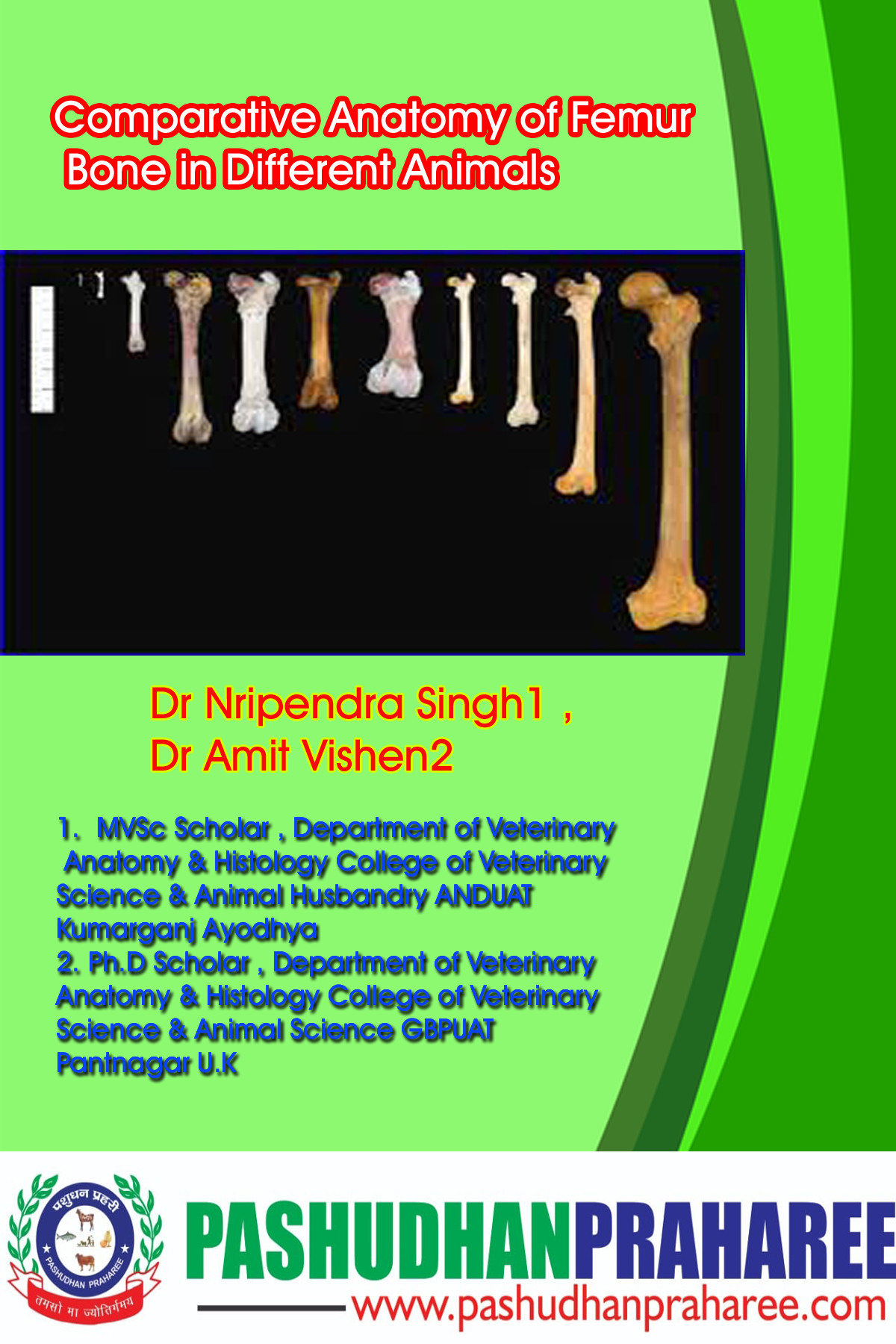Comparative Anatomy of Femur Bone in Different Animals
The most massive of the long bones, extends obliquely downward and forward between the hip and the stifle joints. It consists of a Shaft and two Extremities
Shaft:
- The shaftposses four surfaces. The Anterior, Medial and Lateral surfaces are continuous, convex from side to side and are covered in life by the quadriceps The Posterior face is narrow in the middle where it is rough for the adductor. Below this is an oblique vascular impression running downward and outward marking the course of the femoral vessels. The medial border of posterior surface presents in its upper third the trochanter minor, which is for quadratus femoris and ilio-psoas. Extending from this trochanter obliquely and joining the trochanter major is trochanteric ridge, which forms the postero-lateral boundary of the trochanteric fossa, ridge is for the gluteus medius and fossa forgemellus, obturator externus and obturator internus.
- The distal third of this border carries above the medial condyle the medial supra condyloid crestfor the medial head of the gastrocnemius. The rest of this border below the trochanter minor is for the pectineus.The lateral border presents in its distal third the supracondyloid fossa, which is bounded laterally by the lateral supra-condyloid crest. The fossa for the superficial flexor of the digit and the crest for the lateral head of the gastrocnemius
Proximal extremity
- It composed of the Headand the Trochanter major.The Head is medial and articulates with the acetabulum. The small non-articular sulcus, fovea capitis, on the middle of the head is for the round ligament of the hip joint. The trochanter major or greater trochanter is massive and is for the gluteus medius. The lateral face is convex. Below its base are two rough tubercles -the upper one for themiddle gluteus and the lower one for the deep gluteus.
Distal extremity
- The distal extremityis large and comprises of trochlea in front and two condyles
- The trochleaarticulates with patella. The medial ridge of the trochlea is more prominent. The condyles are separated by the intercondyloid fossa and articulate with the condyles of the tibia through the medium of the interarticular cartilages or menisci.
- The medial condyle presents an eminence on its medial aspect for the medial ligament.
- The lateral condyle presents two depressions on its lateral aspect, the upper one for the lateral ligament of the stifle and the lower one for the Between the lateral condyle and the lateral ridge of the trochlea is, the extensor fossa for the complex muscle. The inter-condyloid fossa lodges the spine of the tibia. Its anterior part is for the posterior crucial ligament. At its posterior part close to the medial condyle is a depression for the coronary ligament of the lateral meniscus and close to the lateral condyle is another depression for the anterior cruciate ligament.
- https://www.pashudhanpraharee.com/important-point-to-be-considered-while-purchasing-dairy-cattle/
Femur of Horse
- More massive
- Third trochanter: extra prominence at the upper lateral border.
- Trochanter minor: in the form of a ridge.
- Fovea capitis: deep and notched.
- Supracondyloid fossa- deeper
- Trochanteric ridge: directed along the length of the bone
- The posterior face bears in its proximal third a rough eminence for the biceps femoris.
Femur of Sheep and Goat
- A distinct line separates the lateral and posterior surfaces.
- The trochanter major is little higher than the head.
- Trochlear ridges are slightly oblique.
Femur of Pig
- The shaft is wide and relatively massive.
- A ridge extends from the trochanter major to the lateral supracondyloid crest and there is no supracondyloid fossa.
- The third trochanter is absent.
- Head is more curved.
Femu of Dog
- shaft: proportionately large and strongly curved with the convexity forward.
- The supra condyloid fossa is absent.
- The trochanteric fossa is rounded and deep.
- The ridges of the trochlea are sagittal and equal.
- The inter condyloid fossa is wide.
- On the posterior aspect of the distal extremity immediately above each condyle is a small facet for a sesamoid-the
- The fabellaeare two small rounded sesamoid bones, located one each on the condyles of the femur on the posterior aspect.
Femur of Fowl
- The head is prominent but smaller than the acetabulumand the articular surface extends on the trochanter and articulates with the acetabulum and the facet on its rim.
- The lateral condyle presents on its lateral aspect a groove for the head of fibula.
Femur of Rabbit
- Immediately below the head is the trochanter minor and lateral to it, a pair of projections, which form the greater trochanter and third trochanter.
- The distal extremity has medial and lateral condyles separated by a median patellar groove
Tabulated Difference of femur in Different Animals
| Sl No. | Osteological Feature | Ox, Sheep, Goat | Horse | Dog |
| 1 | Third trochanter | Absent | Present | Absent |
| 2 | Supracondyloid fossa | Shallow | More deeper | Absent |
| 3 | Fovea capitis femoris | Shallow & located at the Centre of the head | More deeper & located at the neck of the head | Shallow & caudo-lateral to the head
|
| 4 | Trochanteric ridge | Obliquely directed | Straight | Obliquely directed |
Dr Nripendra Singh1 , Dr Amit Vishen2
- MVSc Scholar , Department of Veterinary Anatomy & Histology College of Veterinary Science & Animal Husbandry ANDUAT Kumarganj Ayodhya
- D Scholar , Department of Veterinary Anatomy & Histology College of Veterinary Science & Animal Science GBPUAT Pantnagar U.K


